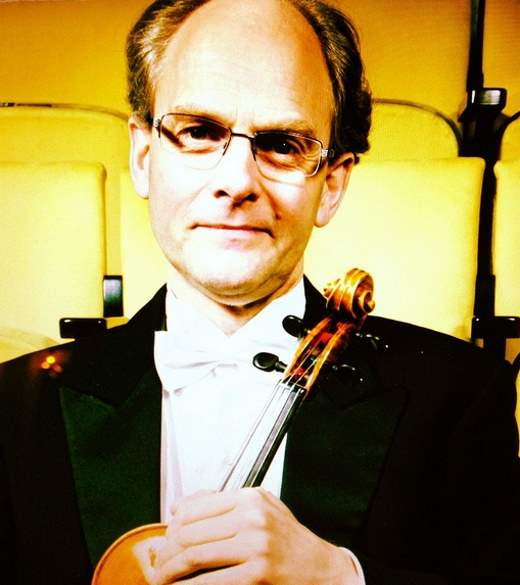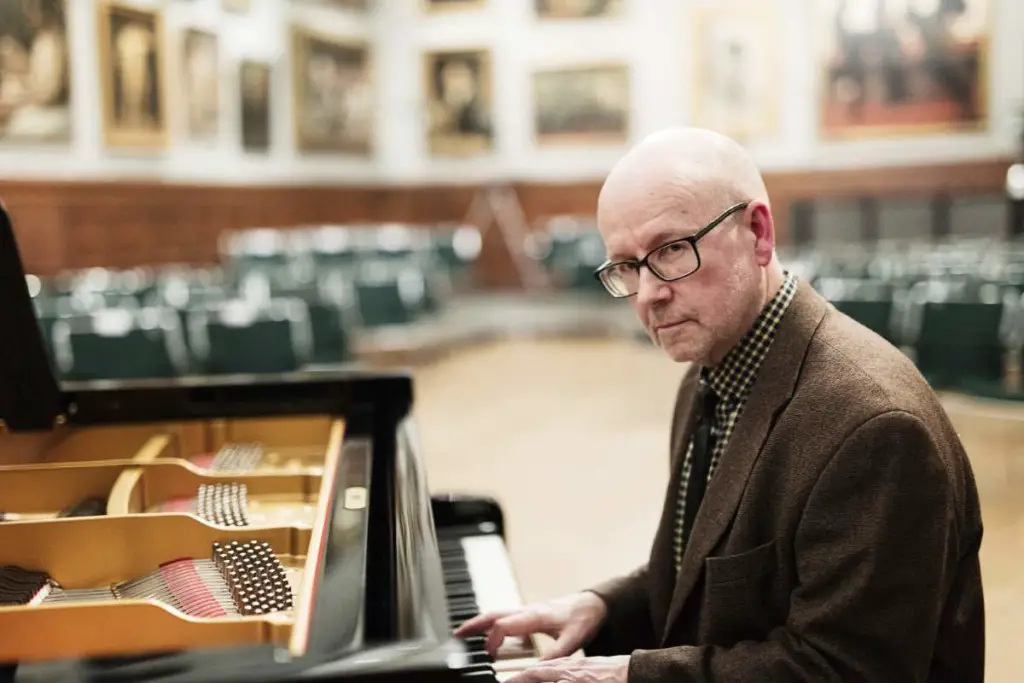Swedish violinist Dan Almgren and the Swedish pianist Stefan Bojsten play Francis Poulenc’s Sonata for violin and piano, FP 119. Recorded by SVT (the Swedish public service broadcaster) in 1985.
Francis Poulenc’s Sonata for Violin and Piano
Francis Poulenc’s Sonata for Violin and Piano is a significant work in the chamber music repertoire, reflecting a blend of intense emotion and neoclassical restraint. Composed during World War II, specifically between 1942 and 1943, it stands as a tribute to the Spanish poet Federico García Lorca, a symbol of the tragic spirit of the war, who had been executed by Nationalist forces at the beginning of the Spanish Civil War in 1936. Poulenc, a member of the French group “Les Six”, was known for his ability to combine wit and sarcasm with deep sentimentality in his music.

This sonata is characterized by its emotional depth and technical sophistication. Poulenc’s style in this work is a fusion of traditional and modern elements. He incorporates classical forms and structures while infusing them with 20th-century harmonic language and rhythmic vitality. The sonata showcases Poulenc’s skill in melody writing, with lyrical and sometimes playful themes that often carry an undercurrent of melancholy. This is reflective of the era’s tension and the personal losses Poulenc experienced during the war.
The piano and violin in this sonata are treated as equal partners, engaging in an intricate dialogue throughout the piece. Poulenc’s piano writing is rich and textured, providing both a harmonic foundation and a counterpoint to the violin’s melodic lines. Conversely, the violin moves between soaring lyrical passages and more introspective moments, often mirroring the emotional landscape of the times.
The premiere of Poulenc’s Sonata for Violin and Piano was in 1943, with the composer himself at the piano and Ginette Neveu, a renowned violinist, handling the violin part. The work was not immediately embraced by all critics, with some finding its stylistic shifts and emotional complexity challenging. However, over time, it has gained recognition as a masterpiece of 20th-century chamber music, admired for its emotional resonance and technical brilliance.
This work was composed by the French composer during World War II, the years between 1942 and 1943, while France was occupied by Germany. Poulenc dedicated the sonata to the memory of Federico García Lorca, who had been executed by Nationalist forces at the beginning of the Spanish Civil War, in 1936. These circumstances and the dedicatee of the piece may explain the dark mood of the work, especially in the first movement.
Movements
1. Allegro con fuoco
The first movement of Francis Poulenc’s Sonata for Violin and Piano is marked “Allegro con fuoco,” which translates to “fast with fire” or “fiery.” This movement sets the tone for the entire sonata, characterized by its dramatic and intense nature.
Opening with a bold and assertive theme in the violin, the music immediately establishes a mood of urgency and passion. The piano responds with equal intensity, providing a rich harmonic backdrop and rhythmic drive that propels the movement forward. This interplay between the violin and piano is a key feature of the movement, showcasing Poulenc’s skill in crafting a dialogue between the two instruments.
The movement is structured in a sonata form, a common architectural form in classical music, comprising an exposition, development, and recapitulation. However, Poulenc infuses this traditional structure with his unique harmonic language and rhythmic vitality. The themes introduced in the exposition are developed with complexity and emotional depth in the development section, where Poulenc explores a range of harmonic and textural possibilities.
One of the striking aspects of this movement is its rhythmic energy. Poulenc employs syncopation and sudden changes in tempo, which add to the sense of urgency and unpredictability. The fiery character of the movement is also reflected in the dynamic contrasts and the bold, assertive nature of the thematic material.
The emotional intensity of the movement doesn’t relent; it builds towards a powerful climax before concluding. The ending of the movement is typically dramatic and decisive, leaving a lasting impression of the passionate and tumultuous world that Poulenc creates through his music.
2. Intermezzo
The second movement of Francis Poulenc’s Sonata for Violin and Piano provides a striking contrast to the fiery and intense first movement. Marked as “Intermezzo,” it serves as a lyrical and more reflective interlude within the sonata. This movement is often noted for its expressive depth and poignant beauty, embodying a different aspect of Poulenc’s compositional style.
Characterized by a calm and introspective mood, the Intermezzo is reflective of Poulenc’s ability to craft melodies of profound emotional resonance. The movement opens with a gentle, singing melody on the violin, supported by a delicate and harmonically rich accompaniment on the piano. This melody has a nostalgic and somewhat melancholic quality, which is a hallmark of Poulenc’s lyrical writing.
The structure of the Intermezzo is relatively simple compared to the other movements, with a clear focus on melodic development and emotional expression. The violin’s line is lyrical and expansive, weaving a narrative that is both intimate and deeply expressive. The piano’s role is not merely supportive; it complements and enhances the violin’s melody, adding depth and color to the overall texture.
Throughout the movement, Poulenc demonstrates his mastery of harmony and texture. The harmonic language is rich but accessible, with lush chords and subtle modulations that enhance the music’s emotional impact. The interplay between the violin and piano is more subdued than in the first movement, yet it remains deeply communicative and engaging.
The overall mood of the Intermezzo is one of introspection and tenderness, a quiet moment of reflection amidst the more dynamic outer movements of the sonata. It showcases Poulenc’s ability to evoke a wide range of emotions within a single work, from the fiery intensity of the first movement to the serene and contemplative character of the second.
3. Presto tragico
The third movement of Francis Poulenc’s Sonata for Violin and Piano marks the conclusion of the sonata and is a return to the energetic and dynamic style found in the first movement. Titled “Presto tragico,” this movement encapsulates both the briskness implied by “Presto” and the dramatic, almost somber, elements suggested by “tragico.”
This final movement is characterized by its rapid tempo and rhythmic vitality. It opens with a sense of urgency and drive that immediately grabs the listener’s attention. The violin part is particularly challenging, featuring fast-paced, virtuosic passages that demand technical prowess and emotional intensity. The piano complements this with equally demanding parts, providing not just rhythmic support but also engaging in a vigorous dialogue with the violin.
The “tragico” element in the title is reflected in the movement’s underlying tension and dramatic flair. Poulenc masterfully weaves a tapestry of emotions, blending moments of high drama with passages of more introspective, yet still intense, character. This balance between the fiery and the more reflective elements gives the movement a profound depth and complexity.
Structurally, the movement is marked by frequent shifts in tempo and dynamics, creating a sense of unpredictability and excitement. Poulenc’s use of dissonance and harmonic tension adds to the dramatic effect, making the music captivating and emotionally charged. The thematic material is developed with ingenuity, displaying Poulenc’s skill in variation and his ability to maintain interest and momentum throughout.
As the concluding movement, it brings the sonata to a powerful and memorable close. The ending is typically dramatic and decisive, with a final burst of energy that resolves the sonata’s emotional journey. The Presto tragico leaves the listener with a sense of resolution, yet it also retains a lingering emotional impact, a testament to Poulenc’s ability to convey profound feelings through his music.
Dan Almgren

Swedish violinist Dan Almgren was born in 1961. He was one of the founders of Stockholm Arts Trio in 1986.
Almgren started playing the violin at the age of three, appeared with the Göteborg Symphony Orchestra at the age of ten, and performed the Mendelssohn Violin Concerto with the Stockholm Royal Philharmonic Orchestra when he was eighteen. In addition to solo engagements and work in chamber music, he is the leader of the Helsingborg Symphony Orchestra.
Stefan Bojsten

Stefan Bojsten is one of the most established and well-known pianists in Sweden. He has appeared as a soloist with most Swedish orchestras and performed all over Scandinavia, Europe, Asia, and North America.
Among many prizes in international piano and chamber music competitions, the height was in 1985 when the duo Bojsten – Almgren won the first prize in one of the world’s biggest chamber music competitions; the Premio Vittorio Gui in Florens which resulted in invitations to festivals and tours all over Europe.
Stefan Bojsten is educated at the Royal College of Music in Stockholm with Esther Bodin-Karpe as his teacher. He has also studied in London and New York, tutored by Phyllis Sellick and Arthur Balsam among others.
Since 1997, Bojsten has been a professor at the Royal College of Music in Stockholm. He is also a frequent masterclass guest at other universities and regularly serves as a jury member in international piano competitions around the world.
Elsewhere in the classical music scene, he is chairman on the board of EPTA-Sweden, (European Piano Teachers Association). He is also a producer for one of Sweden’s currently most renowned music series “Piano Music at the Academy of Arts”.
Bojsten has recorded albums with many major classical labels, including Polar, Caprice, Bis, Naxos, Fermat, Artemis, MAP, recut, Musica Sveciae, and Opus 3.
Sources
- Francis Poulenc – Sonata for violin & piano, FP 119 on allmusic.com
- Dan Almgren on eclassical.com
- stefanbojsten.com
![Poulenc: Concerto for Two Pianos and Orchestra [Mehta/Gewirtzman-Borovitzky]](https://cdn-0.andantemoderato.com/wp-content/uploads/2016/01/Poulenc-Concerto-for-two-pianos-Zubin-Mehta.jpg)